Under cover
29 March 2012 | Extracts, Non-fiction
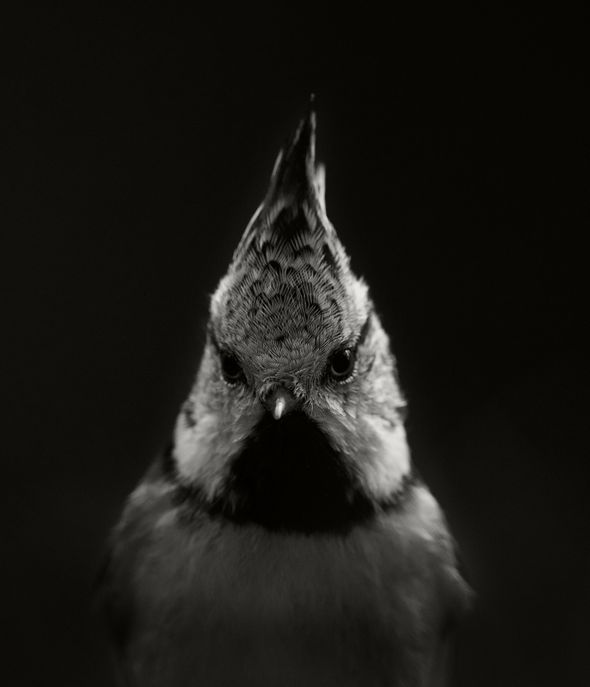
Soul-bird: crested tit. Photo: Heikki Willamo
The photographer and writer Heikki Willamo lived for a year in the forest – not full-time, but for long periods in all seasons, sleeping in his lean-to. This two-hundred, preserved hectare fragment lies in the midst of felled clearings, farmed forest and habitation in southern Finland.
Many Finns still say that being in a forest is a peaceful and empowering experience; Willamo recorded his thoughts on this as well as his black-and-white photographs in his book, Vuosi metsässä (‘A year in the forest’, Maahenki, 2012. See also extracts from Viimeiset vieraat [‘The last visitors’] here)
Spring
Staying put makes you notice slow changes. How snow melts and the pale forest floor gradually turns green. How the ice darkens and the edges of the ponds open up, how the meltwater grows around the stones in the water. When you have a base and a home, it becomes the centre of your existence and thus the focus of the whole forest. Unhurried sitting, making food, brewing coffee and sleeping with open senses brings the life that surrounds you under your skin.
The journey, less than a kilometre, from car to lean-to is like a rite of transition into forest-time. First you skirt a large stone and two ponds, then pass a low ridge and a small defile down to the sunny shore of my home pond. Always the same route beneath the great pine trees to the lean-to, which contains everything I need: cooking utensils, food, coffee, a few clothes, a mattress and a sleeping bag.
The spring days bring the forest closer and closer and regular periods of solitude become a necessity. The worries of everyday life seem to disappear as I step among the great trees. They don’t fall away at the very first footsteps, but after a couple of hours I am reasonably free. The coming of twilight and a night slept in the forest cleans the slate completely and put me on forest-time.
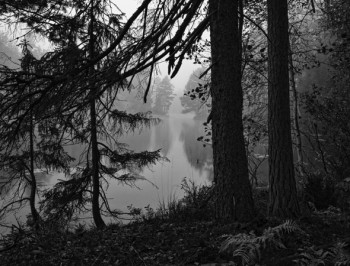
Forest pond: foggy morning. Photo: Heikki Willamo
I begin to call my space metsänpeitto, forest cover. Once, it was something frightening, in which you became the prisoner of the forest and its supernatural powers. You found yourself in an unfamiliar state of being and could not contact anyone who was trying to find you, even if they walking beside you. They, on the other hand, saw you, under your forest cover, as a stone or a tree-stump and could not hear your cries for help.
The world changes, beliefs and myths crumble as things receive their explanations. I am not forced under the cover of the forest; it is a privilege to be there. For me it is a tranquil, place that simplifies and clarifies things.
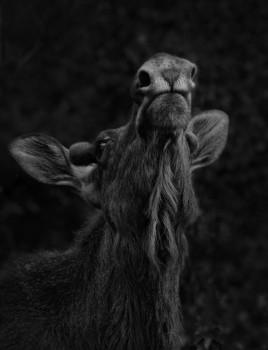
The largest in the forest: the elk. Photo: Heikki Willamo
I discover favourite places: a gorge that leads from one pond to another, a little bluff hidden in a stand of spruce trees, a group of spruces decorated with bushy beard lichen, a great tree-trunk that has fallen to the ground and a jagged boulder whose outlines are softened by moss.
The forest has become familiar; I know almost all the larger trees. For a brief moment I can be lost, but then a familiar fallen tree or boggy hollow tells me exactly where I am.
As I pass by, I always sit down to rest in these nooks. At first I try to take pictures of them, but they are not photographable. Their magic is in their invisible atmosphere.
Sometimes I would like to be a painter, like my grandfather.
Summer
The red-throated divers have begun holding meetings on the larger side of the pond and their cries echo in every corner of the forest. On a mirror-calm morning five birds float near the narrowest part of the strait and an idea comes into my head. I take off my clothes and slip into the water behind a little headland, unseen by the divers.
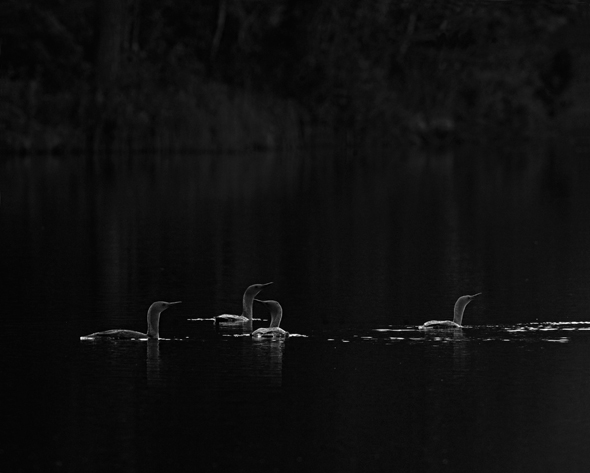
Holding a meeting: red-throated divers. Photo: Heikki Willamo
The water is beautifully warm after a succession of hot days. I dive and wet my head. I swim slowly through the strait. The birds examine my arrival, but do not seem to fear me, or my head floating on the water. When I am a good ten metres from them, the flock begins to swim away. I stop, and the divers stop too. Nothing happens; we take measure of each other with our eyes.
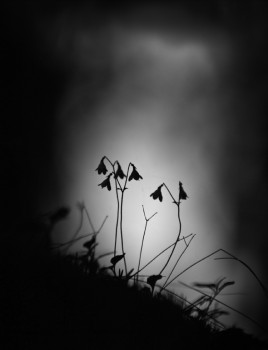
Summer scent: twinflower. Photo: Heikki Willamo
I am not a very good swimmer and I begin to grow tired. I am about to give up when the group sets off, as if prompted by some invisible signal. The birds swim slowly towards me, coming within five metres. I have seen red-throated divers this close up before, but this is something completely different. I am in the water, their element. I see them on the same level, their streamlined form, their waterproof and dense covering of feathers, their dagger beak. And their red lizard-eyes, through which they are staring at me.
I stare back. I would like to know what is going on inside their heads at this moment. What happens in birds’ brains when they are solving a problem? Can it be called thinking, or do we not have a name for it? The divers are confronted by an unfamiliar situation and are trying to understand my head as it floats on the water. Is it dangerous or not? They appear, at any rate, unable to classify it as human.
The birds turn and swim off a little. They concentrate once again on their own business, stretch their necks, swing round, and gather in a circle. In the end they kick down into a dive, reappearing on the surface far away at the other side of the pond.
Autumn
If people have a soul-bird, mine is the crested tit. Of the winged inhabitants of the forest, it is closest of all to me, a fearless, expressive and busy bird. It has myth and magic, it is like the forest itself, an elf in its brown habit and its grey, finely embellished hood. It was in its company that I took my first steps as a photographer of the forest; it acted as a guide to the atmosphere of my own forest. I like it extraordinarily much.
In general, too, working with animals brings me great joy. I can gaze at them forever, following their activities, seeing photographs in my mind and thinking about how to realise them. Everything is entwined to a great extent around pictures, but a large part of my time is spent doing things other than lurking behind a camera.
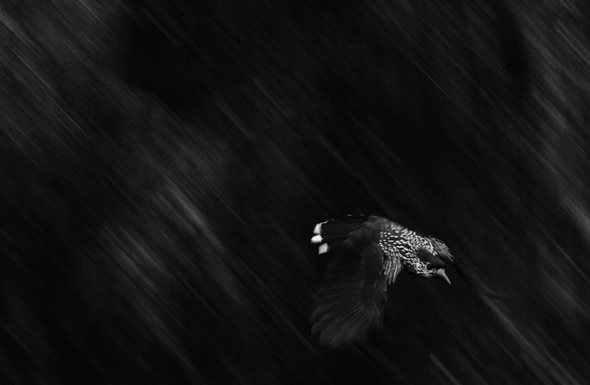
Winging home: a nutcracker. Photo: Heikki Willamo
Photographing animals binds me to the millennial tradition associated with images and the magic of their making. The most ancient images found in Europe are more than thirty thousand years old. And what images they are, the painted horses, bisons, bulls, mammoths, rhinoceroses and cave lions and bears painted on the walls of the Chauvet caves. These pictures, deep in the innards of mother earth, are the dizzying flight of the spirit of the masters of hunter-gatherer society. Why were they made, and what do they mean? The final answer will probably remain unknown, but at least they are a song of praise to animals, their perfection and their beauty.
Winter
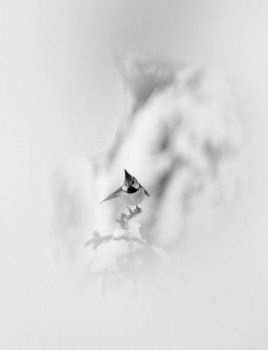
A hooded elf: crested tit. Photo: Heikki Willamo
Now the finest of fine layers of first snow has fallen on the forest. I am almost a year older than on the winter’s day when I first walked here. There is still a good month ahead of me, but the place and the time tempt me to look back. The year has been a good one. It has included moments of both belief and unbelief, existence in the dense forest and breaks from it. In retrospect, everything is easy to place within my internal cycle of seasons.
The heart of winter, especially if it is like the past one, is a fine time, but its turning toward spring extinguishes the spark. April, on the other hand, is full of hope and the flame burns brightly up to midsummer. July and August are a time of leisure, and then comes blessed autumn. It matures the summer, crowns the year and builds a grandiose frame for life in the forest.
In its greyness and quiet melancholia, November is somehow a comforting month. Its dark, rain-blurred days are, for me, a time of taking stock. The old year seeps away; then the first snow cleans the slate and starts something new. It doesn’t go quite according to the calendar, of course, or the length of the day, but my internal clock ticks in time with it.
The quiet peace of winter descends over the landscape; the short days pass quickly. Melancholy begins to raise its head. Soon this will be over. I ask myself over and over again whether I couldn’t go on. It is good here; why break off.
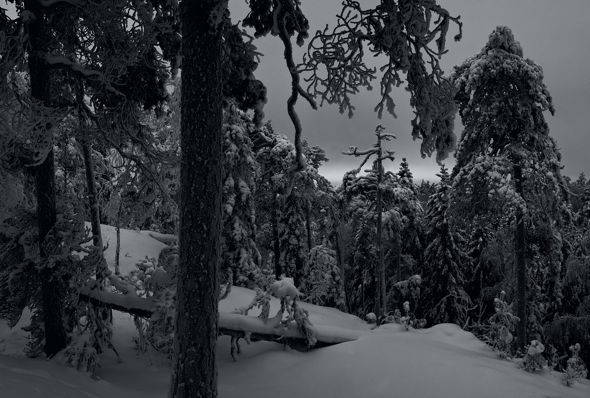
The cycle completed: winter in the forest. Photo: Heikki Willamo
Of course I cannot. The year has gone, pictures have been taken, thoughts pondered and life considered. Now it is time to go away and allow my experiences to settle in their places.
Translated by Hildi Hawkins
Extracts from Vuosi metsässä (‘A year in the forest’) by Heikki Willamo. Published by Maahenki, 2012 (ISBN 978-952-5870-59-6). Swedish-language edition: Skogsåret (978-952-5870-60-2)
Tags: Finnish nature, photography
1 comment:

25 June 2012 on 3:34 pm
Gorgeous. You captured the quietness and peace of the forest and the silent beauty. My GreatGrandparents were Finnish and now I know why they settled in Michigan of the U.S.. because it is so similar. (we even have an elk population coming back up)